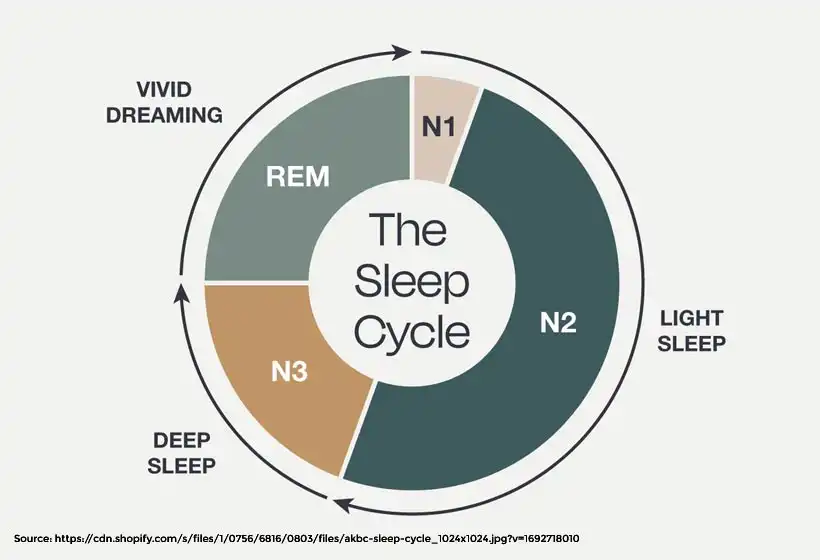NREM Sleep Cycle Vs. LOL | Sleep 2025

Sleep is a vital component of overall health. Yet many people often focus solely on the number of hours they sleep.
However, the quality of sleep, and how efficiently you progress through each phase of the sleep cycle, plays a significant role. One of the most important aspects involves the stages of the NREM (Non-Rapid Eye Movement) sleep cycle. It has a connection with our body’s lymph system, specifically lymph obligatory load (LOL).
Today, we’ll explore the 3 stages of NREM sleep. We will discuss the importance of a full sleep cycle for physical and mental health. We will also take a closer look at how LOL interacts with different sleep positions.
What is Sleep Cycle?
Sleep is a highly dynamic process. It moves through different phases throughout the night. The human sleep cycle consists of 4 stages: 3 NREM stages and 1 REM (Rapid Eye Movement) stage.
These stages occur multiple times throughout the night. According to a source, on average, a person goes through four to six cycles, with each cycle typically lasting about 90 minutes.
However, the duration of each stage can vary depending on several factors, including age, lifestyle, and health conditions. Understanding these stages can provide valuable insights into how well-rested we truly are upon waking. Here’s a breakdown of the stages of sleep in 2025:
1. Stage 1: NREM Sleep (N1)
- The first stage of NREM, known as N1, is the initial phase when you transition from wakefulness into sleep.
- This stage typically lasts for one to seven minutes. Your body and brain activities slow down, and your muscles begin to relax.
- It’s easy to wake up during this stage, as it’s a light form of sleep. However, as the night progresses, the time spent in this stage tends to decrease, and your body moves into deeper stages of sleep.
2. Stage 2: NREM Sleep (N2)
- Stage 2, or N2, is a deeper stage of NREM. It typically lasts 10 to 25 minutes in the first sleep cycle but lengthens with each subsequent cycle.
- In this phase, the body’s temperature drops, heart rate, and breathing slow down, and muscle relaxation deepens.
- Brain waves begin to show a distinct pattern, with short bursts of activity known as sleep spindles.
- These bursts help to protect your sleep by preventing external stimuli from waking you up.
- Approximately half of your total sleep time is spent in Stage 2 sleep, making it a critical phase for restful sleep.
3. Stage 3: NREM Sleep (N3)
- Stage 3, also known as deep sleep or slow-wave sleep (SWS), is the most restorative stage of NREM sleep.
- It’s during this stage that the body’s muscle tone, pulse, and breathing rate decrease significantly.
- Brain activity slows to delta waves, which are the slowest and largest brainwaves.
- Stage 3 sleep is crucial for bodily recovery, immune system boosting, and cellular repair. It’s also linked to improved memory and cognitive function.
- The first half of the night is dominated by deep sleep, but as the night progresses, the amount of time spent in Stage 3 decreases, and more time is spent in REM sleep.
4. Stage 4: REM Sleep
- REM sleep is the phase of sleep most associated with vivid dreaming. It usually begins 90 minutes after you fall asleep and lasts longer in the latter sleep cycles.
- During REM sleep, brain activity surges to levels close to wakefulness, while the body enters a state of atonia, meaning it temporarily loses the ability to move (with the exception of the eyes and breathing muscles).
- REM sleep is thought to play a crucial role in memory consolidation, emotional regulation, and learning.
- Although REM sleep is a lighter stage of sleep, it’s essential for cognitive functions such as memory and creativity.
Importance of NREM Sleep Cycle | Sleep 2025

The NREM sleep cycle plays a fundamental role in your ability to wake up. Each stage is vital for different aspects of health, including immune function, memory consolidation, muscle recovery, and even emotional well-being.
However, it’s not just about getting the required amount of sleep. It’s about allowing your body to progress naturally through these stages without interruption.
Sleep disorders such as insomnia or obstructive sleep apnea can severely disrupt this cycle. It prevents the body from entering the deeper stages of NREM sleep. Disruptions in the NREM cycle may result in sleep that’s insufficiently restorative. This may lead to symptoms such as fatigue, irritability, and difficulty concentrating during the day.
Are you struggling with sleep? Discover the 5 types of sleep disorders!
Maintaining good sleep hygiene is essential for promoting smooth transitions through each of the 4 stages of the sleep cycle. This includes
- creating a sleep-friendly environment,
- sticking to a consistent sleep schedule,
- managing stress, and,
- avoiding substances like alcohol that can alter sleep architecture.
Lymph Obligatory Load (LOL) and Its Impact on Sleep
While much of the focus on sleep quality has revolved around sleep stages, the lymph system and its lymph obligatory load (LOL) also play a critical role in how well we sleep. The lymphatic system is responsible for removing waste and toxins from the body, and its activity increases during sleep.
What is Lymph Obligatory Load (LOL)?
Lymph Obligatory Load (LOL) refers to the body’s necessary lymphatic load during sleep. It directly influences the body’s detoxification and waste-removal processes. As you sleep, your body undergoes various processes of repair and renewal. This includes the clearance of metabolic waste products.
Research has shown that the lymphatic system works in tandem with the sleep cycle to remove neurotoxic waste from the brain. It is specifically during deep sleep (Stage 3). Inadequate lymphatic function or a high LOL can disrupt these processes, potentially leading to cognitive decline or disrupted sleep.
How Does LOL Affect Sleep?
The relationship between LOL and sleep is complex. For example, in some cases, a higher LOL may result in more fragmented sleep, especially if the lymphatic system is overloaded or not functioning optimally. When the body struggles to clear waste, it can lead to a disrupted sleep cycle, particularly during deep sleep stages like N3.
Furthermore, studies have found that improper clearance of neurotoxic waste during sleep. It may be associated with neurodegenerative conditions, such as Alzheimer’s disease.
This highlights the importance of efficient lymphatic drainage during sleep for cognitive health and overall well-being.
How LOL is Linked to Sleep Position?
Sleep positions can influence the body’s ability to manage lymphatic load and waste clearance. For example, sleeping on your left side is often recommended for improved lymphatic drainage. It facilitates the proper functioning of the lymphatic system and encourages better detoxification processes during sleep.
On the other hand, sleeping in positions that compress certain areas of the body or limit the flow of lymphatic fluid may hinder the body’s ability to detoxify efficiently. This can lead to increased levels of lymphatic load, potentially causing disruptions in the sleep cycle.
LOL and Sleep 2025: What’s Next?
As we look toward the future of sleep in 2025, understanding the intricate relationship between LOL and sleep quality will likely become more prominent. With advancements in sleep-tracking technology, we may soon have more personalized insights into how lymphatic drainage interacts with the different stages of the sleep cycle.
These insights could lead to new sleep aids, sleep therapies, or lifestyle recommendations.
While research into LOL and sleep is still in its early stages, there are several ways you can optimize your sleep hygiene. It ensures you’re supporting both your sleep cycle and lymphatic health. Here are the ways:
- Prioritize Sleep Hygiene: Ensure that your sleep environment is conducive to restful sleep by keeping the room cool, dark, and quiet. Use comfortable bedding, and avoid distractions like screens before bed.
- Sleep Position Matters: Consider sleeping on your left side to promote better lymphatic drainage. If you’re unsure about your ideal position, experimenting with different options may help.
- Stay Hydrated: Proper hydration supports lymphatic function, so make sure you’re drinking enough water throughout the day to help your body clear toxins.
- Exercise Regularly: Regular physical activity can boost lymphatic function. It helps your body handle its obligatory load more efficiently during sleep.
- Manage Stress: Chronic stress can interfere with sleep and affect the body’s lymphatic function. Practicing relaxation techniques, such as deep breathing or meditation, can be beneficial.
Ready to improve your sleep? Discover the top 10 tips for better sleep hygiene!
The sleep cycle, particularly NREM sleep and the role of lymph obligatory load (LOL), is more complex than we once thought. By understanding the stages of sleep and how the lymphatic system impacts rest, we can better appreciate the critical factors that contribute to high-quality sleep in 2025.
Disclaimer
This blog is intended for informational purposes only. It should not be considered medical advice. The content, including details about sleep stages, NREM, REM cycles, and any references to lymph obligatory load, is provided to enhance general understanding and awareness.
Always consult a qualified healthcare professional for personalized advice and guidance on sleep health or any medical concerns.
